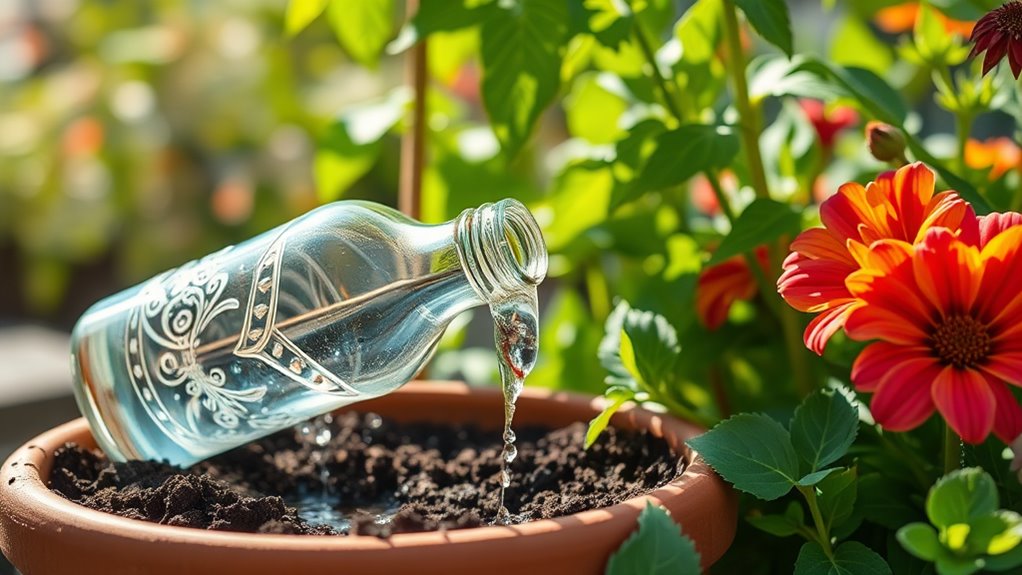This Watering Hack Saved My Thirsty Plants
If you’ve ever struggled to keep your plants hydrated, you’re not alone. Many gardeners face this challenge, where overwatering and underwatering can both lead to wilting. However, there’s a method that shifts the focus from surface watering to the roots, transforming thirsty plants into vibrant ones. By implementing an effective watering strategy, you can achieve healthier foliage and stronger roots. Curious about how this approach works? Let’s explore the details.
Understanding Plant Water Needs
Understanding the water needs of your plants is crucial for their health and vitality.
By observing key factors like soil moisture, plant variety, and environmental conditions, you can tailor your watering tips effectively.
Remember to water deeply yet infrequently, ensuring roots grow strong and resilient.
Paying attention to these needs helps prevent overwatering or underwatering, keeping your plants thriving.
Additionally, using a soil moisture meter can help you accurately gauge when your plants need water, avoiding common watering mistakes.
The Benefits of Deep Watering
When you water your plants deeply, you’re not just quenching their thirst; you’re promoting a robust root system that can better withstand drought and stress.
Deep watering encourages roots to grow downwards, accessing nutrients and moisture from farther soil layers. This strengthens your plants, enhances their resilience, and reduces the frequency of watering. Ultimately, it leads to healthier, thriving plants. Additionally, effective watering methods can significantly improve water conservation in your garden.
Innovative Watering Methods
While deep watering lays the foundation for strong plant health, exploring innovative watering methods can elevate your gardening game to new heights. Techniques like drip irrigation and self-watering systems not only conserve water but also ensure your plants receive consistent moisture. Incorporating watering schedules into your routine can further enhance the effectiveness of these methods.
| Method | Benefits |
|---|---|
| Drip Irrigation | Efficient, targeted watering |
| Self-Watering Systems | Consistent moisture supply |
| Watering Globes | Simplifies care for potted plants |
Using Mulch for Moisture Retention
By applying a layer of mulch around your plants, you can significantly enhance moisture retention in the soil.
Mulch acts as a protective barrier, reducing evaporation and regulating soil temperature.
Organic materials, like wood chips or straw, not only improve moisture retention but also enrich the soil as they decompose. Moreover, incorporating innovative mulching practices can further boost soil health and promote sustainable gardening.
Embrace this simple yet effective practice to keep your plants thriving and hydrated!
Timing Your Watering for Optimal Results
To achieve optimal results in your watering routine, understanding the timing is crucial.
Water early in the morning or late in the evening to minimize evaporation. Monitor weather conditions; during hot spells, increase frequency.
Aim for deep watering sessions, encouraging root systems to develop strong. Consistency is key, so establish a schedule based on your plants’ specific needs for ultimate growth and health. Additionally, consider implementing efficient schedules to streamline your watering process and ensure your plants receive adequate hydration even on your busiest days.
Troubleshooting Common Watering Issues
When you notice your plants struggling despite your best watering efforts, it’s essential to identify the underlying issues causing the problem. Below are common watering issues and their solutions:
| Problem | Solution |
|---|---|
| Overwatering | Allow soil to dry out |
| Underwatering | Increase watering frequency |
| Poor drainage | Amend soil with perlite |
It’s also important to consider that different plants have varying specific needs when it comes to watering frequency and quantity.

